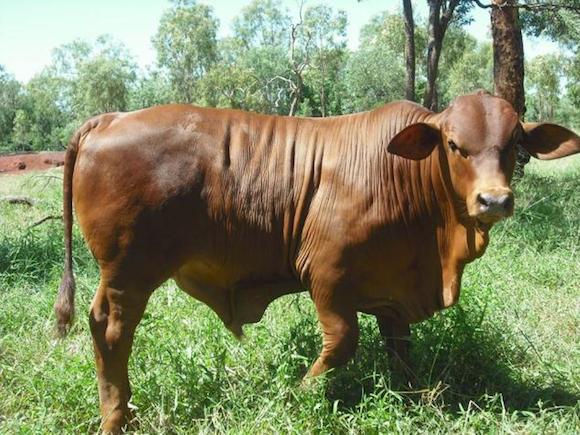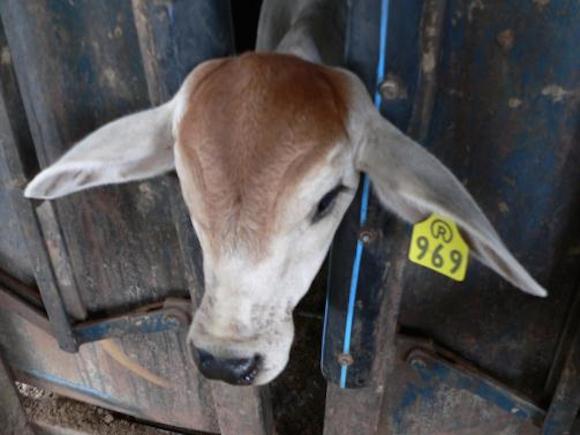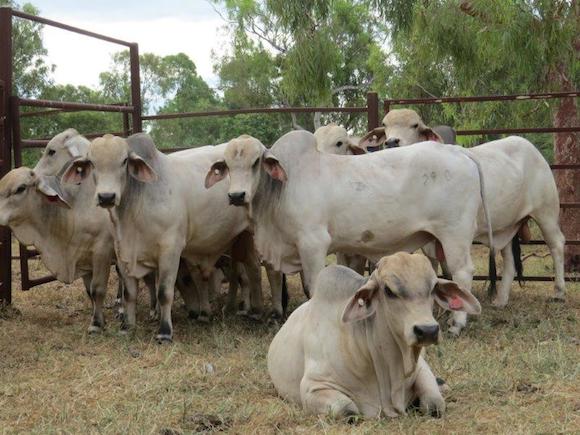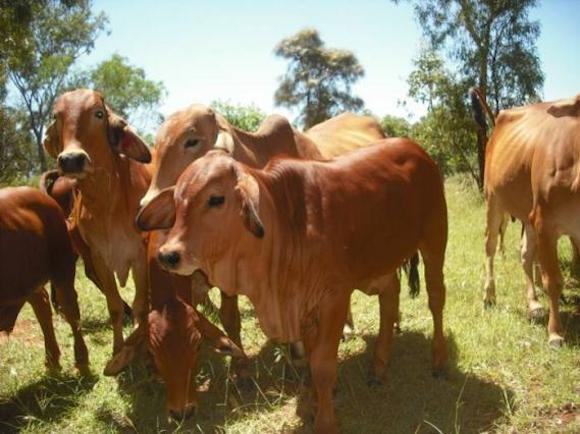Horns, tail hair, and “second bum holes”
Host: Katherine Research Station
Written by Trisha Cowley – Beef Cattle Extension Office, DPIF.
I can still vividly remember being told about the ringer who was horned by a scrub bull which gave him a “second bum hole”, or so the storyteller said. Horns on cattle are definitely dangerous, particularly with the increasing proportion of stationhands who have zero to one years’ experience under their belt and aren’t as savvy around cattle. While I like to think that I am not too bad on my feet around cattle, my braveness in the yards evaporates pretty quickly when a big set of horns turn up! Horns are also dangerous for other cattle, especially during transport and yard work, when they are in confined spaces and can’t escape from bullies.
Traditionally the beef industry has worked to protect people and cattle from the danger of horns through dehorning, the process of physically removing the horn at a young age. However, some producers have instead taken the option of breeding polled (i.e. naturally hornless) cattle, eliminating the need to dehorn.
This isn’t as easy as it sounds though. The proportion of polled to horned cattle is low in many breeds, including Brahmans, which are the predominant cattle breed in the northern NT due to their hardiness and tropical adaption to heat, humidity, and parasites. Further, just because an animal is polled, doesn’t mean that it only passes on polled genetics to its offspring.
But before I get carried away (I get excited talking about my work!), I’d better introduce myself. I am Trisha Cowley and I work as a Beef Cattle Extension officer for DPIF and am based at the Katherine Research Station. My husband and I have recently got into the cattle game too, which allows me to put my money where my mouth is! I work with producers to take the results from research projects and apply it practically in the paddock. I’ve got a pretty cool job. For a start I live in the NT, secondly I get to work with cows and thirdly, I get to work with leading cattle producers who never fail to inspire and motivate me! I grew up on a sheep and cattle farm in south west Queensland and am living proof of the saying that “you can take the girl out of the bush but you can’t take the bush out of the girl”. I went to university in Brisbane and studied psychology after my parents urged me to do anything BUT agriculture, but then decided to head to the NT for a year of fun jillarooing. Eleven years later I am still here, with no desire to head back south just yet!
 What I spend my spare time doing – playing with cows, dogs and dust!
What I spend my spare time doing – playing with cows, dogs and dust!
At the moment I am working with a couple of producers in the Katherine region who have been introducing polled genetics into their herds for the past 5-10 years. Both Garry and Michelle Riggs from Lakefield Station and Keith and Roxie Holzwart from Avago Station are breeding the horns off their cattle as they believe it results in better welfare for the animals, better production through minimising the post-weaning growth setback and in order to meet future animal welfare expectations of the broader community. Both families have been breeding polled bulls for their own use for a number of years, chiefly due to the difficulty in sourcing good polled genetics.
 The Holzwarts have been happy with the growth and temperament of the Brahman x Senepol F1 progeny with most being scurred.
The Holzwarts have been happy with the growth and temperament of the Brahman x Senepol F1 progeny with most being scurred.
Unfortunately, polled Brahman stud breeders are few and far between, and while this is certainly changing, both families have found it difficult to source bulls which tick all the boxes – polledness, fertility, structural soundness, and temperament. It was particularly frustrating buying a bull which the vendors claimed was “true polled”, but in fact was a carrier of horns.
Let me give you a quick Polled Genetics 101 lesson! The polled gene has 2 forms; polled (P) or horned (H). Every animal has two copies of the polled gene, so potentially they could be PP, PH or HH. The polled form is dominant over the horned form. This means that only HH animals are horned. It is slightly more complicated than that, as there is an interaction from another gene which controls scurs, which are loose horny growths that are not attached to the skull. PP animals are polled, but PH animals are either polled or scurred, but some are also horned. Are you confused yet!?
An animal gets one copy of the polled gene from its mother and one copy from its father, and consequently randomly passes on one of its copies to its progeny. PP animals are considered “true polled” as they pass on the polled copy to 100% of their progeny. However, PH animals are carriers of horn, and will only pass on a polled copy to half of their progeny. Therefore, using PP sires in preference to PH sires will speed up the time taken to breed a polled herd. Since PP and PH animals can both be visually polled, it is desirable to be able to distinguish between them. Typically it can take 30 years to change a horned herd into a polled herd through visual selection. Now though, thanks to CSIRO, the Beef CRC and Meat and Livestock Australia (MLA), there is a DNA test available that takes the guess work out of it by determining whether an animal is PP, PH or HH, all through a tail hair sample. Using the test to select PP cattle can reduce the time taken to breed to breed a polled herd by 20 years.
 A PP calf at Lakefield, getting tagged, weighed, and tail hair sampled. Out of 20 polled calves, only five were PP.
A PP calf at Lakefield, getting tagged, weighed, and tail hair sampled. Out of 20 polled calves, only five were PP.
Keith and Roxie and Garry and Michelle now use the Polled DNA Test to source PP bulls and to make selection decisions in their own stud herds. They are part of a MLA funded project which is demonstrating the practical use of the Polled DNA test in breeding polled bulls. As part of the project, we are testing progeny of PP bulls in their stud herd. From visual assessments at branding at Lakefield Station, 66% of progeny were polled and 34% were scurred, thus no calves needed dehorning – an excellent result. DNA testing revealed that 75% were heterozygous polled (PH) and 17% were homozygous polled (PP). While it will take some years before Garry and Michelle reach a pure polled herd, using a PP bull had immediate effect through removing the need to dehorn.
We are doing a similar demonstration at Avago, including comparing the proportion of polled, horned, and scurred progeny from using PP versus PH bulls, which will demonstrate the ultimate power of using the Polled DNA test. Keith and Roxie are weaning the progeny soon and will be holding a field day to provide the results later in the year.
 Temperament is one of Keith and Roxie’s key selection criteria – which this calf passed with flying colours, but unfortunately he was PH!
Temperament is one of Keith and Roxie’s key selection criteria – which this calf passed with flying colours, but unfortunately he was PH!
This project is yet another example of the beef industry adopting new technology and management practices as they continually strive to improve the welfare of animals under their care, while improving productivity and profitability. Hats off to them. The ingenuity and commitment of producers never fails to inspire me – I have a pretty special job which allows me to learn from and work with families like the Riggs’ and the Holzwarts’ every day.
For those wanting more information about the Polled DNA test, contact Pfizer Animal Genetics or University of Queensland who both offer the service. All it takes is a tail hair sample and about $25-$30. A small price to pay for ensuring you are getting a PP not PH bull!
www.pfizeranimalgenetics.com.au ; http://www.uq.edu.au/vetschool/agl
 A few promising looking weaners from Lakefield’s stud herd.
A few promising looking weaners from Lakefield’s stud herd.
 A line of grey, polled, and scurred home bred bulls at Avago.
A line of grey, polled, and scurred home bred bulls at Avago.
 A lovely polled weaner from Avago – will she be PP or PH?
A lovely polled weaner from Avago – will she be PP or PH?
 A stud cow at Lakefield minding the little ones while the other mums feed.
A stud cow at Lakefield minding the little ones while the other mums feed.

